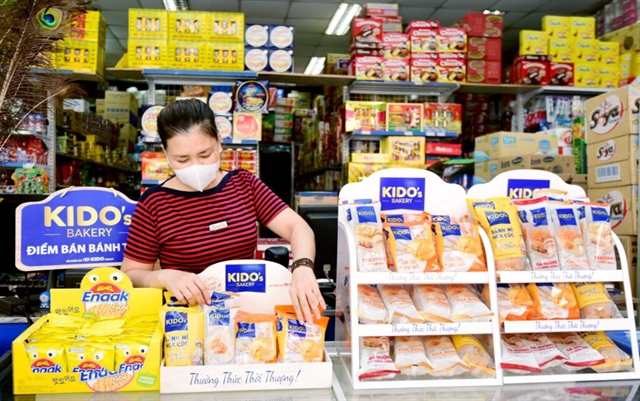While some companies are thriving, others struggle to maintain their footing in a changing confectionery market.

A shop of KIDO in HCM City. — Photo courtesy of the company
In 2024, Vietnam’s confectionery industry finds itself at a crossroads, navigating both promising opportunities and formidable challenges.
The market, which traditionally enjoys strong demand during festive seasons, is witnessing shifts in consumer preferences, rising costs and fierce competition.
While some companies are thriving, others struggle to maintain their footing. The year has proved to be a true test of resilience for businesses aiming to solidify their market presence.
Despite economic uncertainties, certain confectionery businesses in the country have reported remarkable growth.
One standout performer is Hữu Nghị Food JSC, which, despite a two per cent decline in fourth-quarter (Q4) revenue to VNĐ620 billion (US$24.3 million), managed to increase its gross profit by 12 per cent to VNĐ201 billion.
This improvement was achieved through a strategic reduction in production costs, enhancing the company’s gross margin from 28 per cent to 32 per cent.
As a result, its profit after tax surged by 2.5 times to VNĐ71.8 billion for the quarter, culminating in an annual net profit of VNĐ178 billion, an impressive 150.7 per cent increase compared to the previous year.
Similarly, Bibica Corporation enjoyed a successful year, reporting a 19 per cent increase in net revenue to VNĐ1.78 trillion. This translated into a 25 per cent rise in gross profit, totalling VNĐ621 billion, while net profit grew by 20 per cent to VNĐ116 billion.
The company outperformed its revenue and profit targets, signaling strong consumer demand and effective business strategies.
Struggles and shortcomings
Not all companies have been as fortunate.
Hải Hà Confectionery JSC, despite its long-standing reputation in the industry, faced a 10 per cent decline in revenue to nearly VNĐ777.2 billion.
While financial measures helped stabilise gross profits, the company’s bottom line was unable to meet expectations. Profit before tax was nearly VNĐ64 billion, down slightly 0.1 per cent, while net profit increased by a modest 2 per cent to VNĐ50.3 billion.
As a result, Hải Hà fell short of its ambitious target of VNĐ1.2 trillion in revenue and VNĐ70 billion in profit before tax.
KIDO Group Corporation reported growth in Q4 2024, but faced an overall decline for the year.
Despite diversifying into sectors like ice cream and cooking oil, the company's profitability remained weak.
In Q4, KIDO's net revenue reached nearly VNĐ2.6 trillion, a 29 per cent increase year-on-year, with gross profit rising 22 per cent to VNĐ472 billion despite high costs.
Financial expenses dropped by 93 per cent to VNĐ48 billion, but selling and administrative expenses surged significantly by 62 per cent and 243 per cent, respectively.
This led to a profit of VNĐ13.7 billion, an improvement from the VNĐ551 billion loss in the same quarter last year.
For the entire year, KIDO posted net revenue of over VNĐ8.3 trillion, down 3.7 per cent year-on-year, and profit after tax fell by 50 per cent to VNĐ67 billion, the lowest in 15 years.
The struggle of companies like Hải Hà and KIDO underscores the industry’s shifting landscape, where traditional strategies may no longer be sufficient to capture a changing market. — BIZHUB/VNS
Read original article here